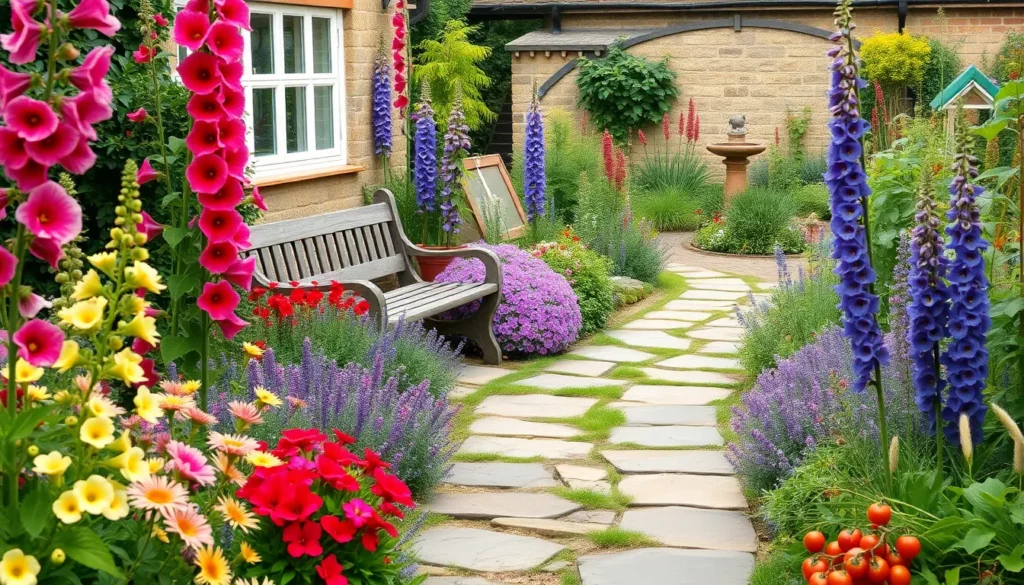Creating a stunning garden in the UK presents unique opportunities and exciting challenges that we’ve mastered through years of experience. Our climate offers distinct advantages with its moderate temperatures and ample rainfall, allowing us to cultivate diverse plants that thrive in British conditions.
We understand that designing the perfect UK garden requires balancing practical considerations with aesthetic appeal. From dealing with unpredictable weather patterns to maximizing limited space, we’ve discovered innovative answers that transform ordinary outdoor areas into breathtaking sanctuaries.
Whether you’re working with a compact city courtyard or sprawling countryside acreage, we’ll share proven strategies that work specifically for British gardens. Our tested approaches help you create year-round interest while embracing native plants and sustainable practices that flourish in our unique environment.
Create a Traditional English Cottage Garden
Traditional English cottage gardens perfectly complement the UK’s natural climate and offer timeless charm that works beautifully in both small and large spaces.
Choose Heritage Plant Varieties
Heritage plant varieties form the foundation of an authentic cottage garden design. We recommend selecting time-tested perennials like hollyhocks, delphiniums, and foxgloves that have thrived in British gardens for centuries. Traditional herbs such as lavender, rosemary, and thyme provide both fragrance and practical benefits while requiring minimal maintenance.
Cottage garden classics include sweet peas, poppies, and cornflowers that self-seed naturally and create that effortless abundance. We’ve found that old-fashioned roses like ‘Gertrude Jekyll’ and ‘Graham Thomas’ offer exceptional disease resistance and repeat flowering throughout the season. Native wildflowers such as meadowsweet, lady’s mantle, and campanula blend seamlessly with cultivated varieties.
Selecting plants that naturalize easily reduces ongoing maintenance while maintaining authentic cottage garden character. We suggest incorporating edible flowers like nasturtiums and calendulas that add color while serving culinary purposes.
Design Curved Pathways and Borders
Curved pathways create the informal, meandering feel essential to cottage garden design. We recommend using natural materials like reclaimed brick, weathered stone, or gravel paths that soften over time and develop character. Gently winding routes encourage exploration and make small gardens feel larger than their actual size.
Irregular border shapes work better than straight lines for achieving authentic cottage garden aesthetics. We’ve observed that kidney-shaped beds and flowing curves create visual interest while providing varied growing conditions for different plants. Mixed plantings along pathway edges blur the boundaries between cultivated and wild areas.
Creating different path widths adds functionality and visual appeal throughout the garden space. We suggest wider areas for seating or gathering spots and narrower sections that create intimate garden rooms. Natural stepping stones through planted areas extend the informal pathway system.
Incorporate Climbing Roses and Honeysuckle
Climbing roses and honeysuckle provide essential vertical elements that define cottage garden architecture. We recommend training these climbers over arches, pergolas, and existing structures to create natural garden rooms and privacy screens. English roses like ‘Constance Spry’ and ‘Heritage’ offer exceptional fragrance and disease resistance for UK conditions.
Honeysuckle varieties such as Lonicera periclymenum ‘Belgica’ provide evening fragrance and attract beneficial wildlife throughout the growing season. We’ve found that combining different climbing plants creates extended flowering periods and varied textures on vertical surfaces. Native honeysuckle supports local moth and butterfly populations while requiring minimal intervention.
Training climbers through existing trees and shrubs maximizes growing space in smaller gardens. We suggest using natural supports like hazel poles and willow structures that blend with the informal cottage garden aesthetic while providing necessary plant support.
Design a Modern Urban Balcony Garden
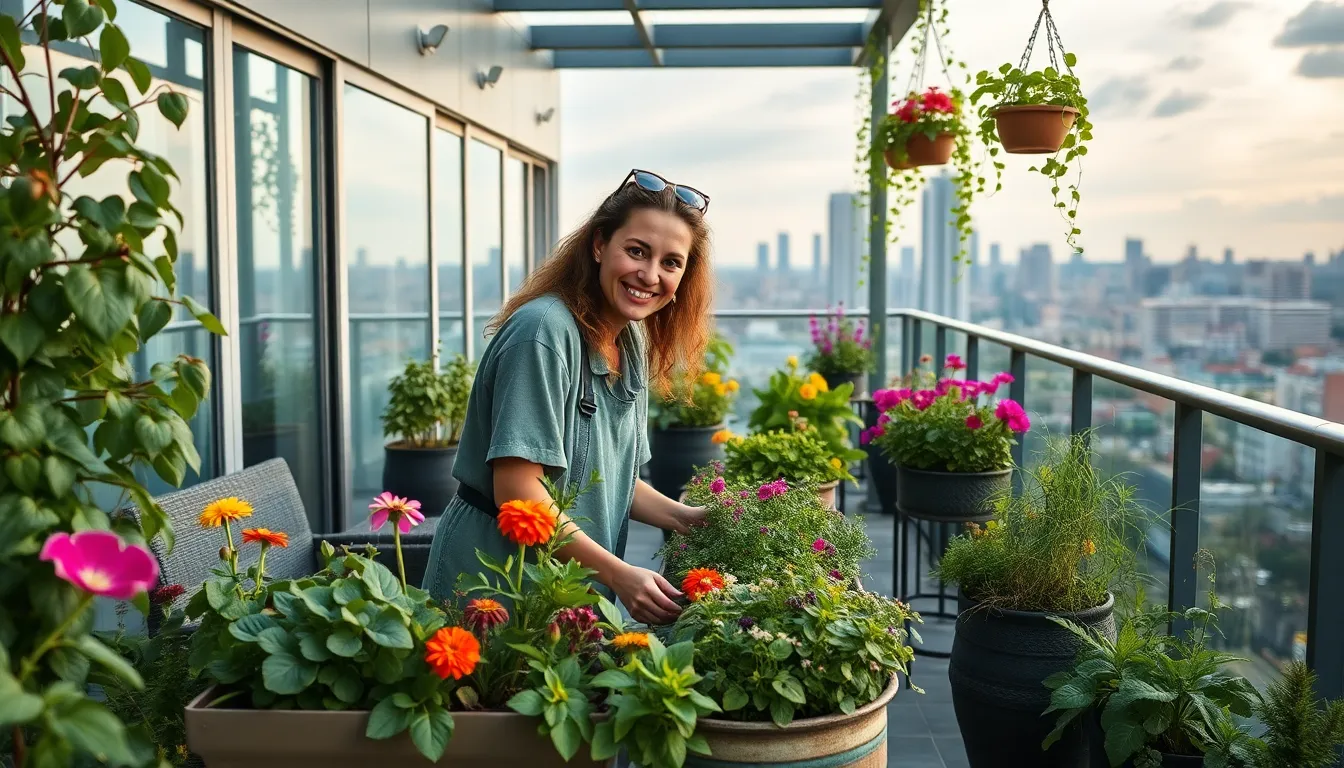
Urban balconies present unique opportunities to create beautiful green spaces even in the heart of the city. We’ll transform your limited outdoor space into a thriving garden sanctuary that maximizes every square foot.
Select Compact Container Plants
Pollinator friendly plants create the foundation of any successful balcony garden. Lavender and sunflowers attract bees and butterflies while adding vibrant colors and pleasant fragrances to your outdoor space. These hardy selections thrive in containers and require minimal maintenance once established.
Herbs and vegetables bring both beauty and functionality to your urban garden. Basil and mint provide fresh ingredients for your kitchen while releasing aromatic scents throughout your balcony. Cherry tomatoes and leafy greens like spinach and lettuce grow exceptionally well in compact containers and deliver fresh produce right to your doorstep.
Container selection directly impacts plant health and growth success. We recommend choosing pots with proper drainage holes and using quality potting mix that supports healthy root development. Size your containers appropriately for each plant type, ensuring herbs have at least 6 inch deep pots while vegetables need 12 inch or deeper containers.
Install Vertical Growing Systems
Hanging baskets and tiered planters maximize your growing space while creating stunning visual displays. These systems allow us to grow multiple plant varieties without consuming valuable floor space. Position trailing plants like petunias or ivy in higher baskets to create cascading effects that soften hard balcony edges.
Wall mounted pockets work perfectly for plants requiring minimal soil depth. Succulents and ferns thrive in these compact growing environments while adding textural interest to blank walls. Install pocket systems at varying heights to create ever-changing vertical gardens that draw the eye upward.
Climbing plants transform balcony railings and walls into living screens. Clematis and morning glories create lush, cascading effects that provide privacy while adding natural beauty. Support these vertical growers with trellises or wire systems that complement your balcony’s architectural features.
Choose Weather Resistant Furniture
Durability considerations should guide every furniture selection decision. Materials like recycled plastic, metal, and sustainably sourced wood withstand UK weather conditions while maintaining their appearance season after season. We prioritize pieces that resist fading, cracking, and rust formation.
Style and function balance ensures your outdoor furniture serves multiple purposes. Outdoor sofas and coffee tables create comfortable seating areas while complementing your garden’s overall design aesthetic. Select pieces with clean lines and neutral colors that won’t compete with your plant displays.
Space optimization becomes crucial in compact balcony environments. Folding chairs and nesting tables provide flexibility when entertaining while storing efficiently during off seasons. Built in storage benches offer seating plus space for gardening tools and supplies.
Build a Wildlife-Friendly Garden Haven
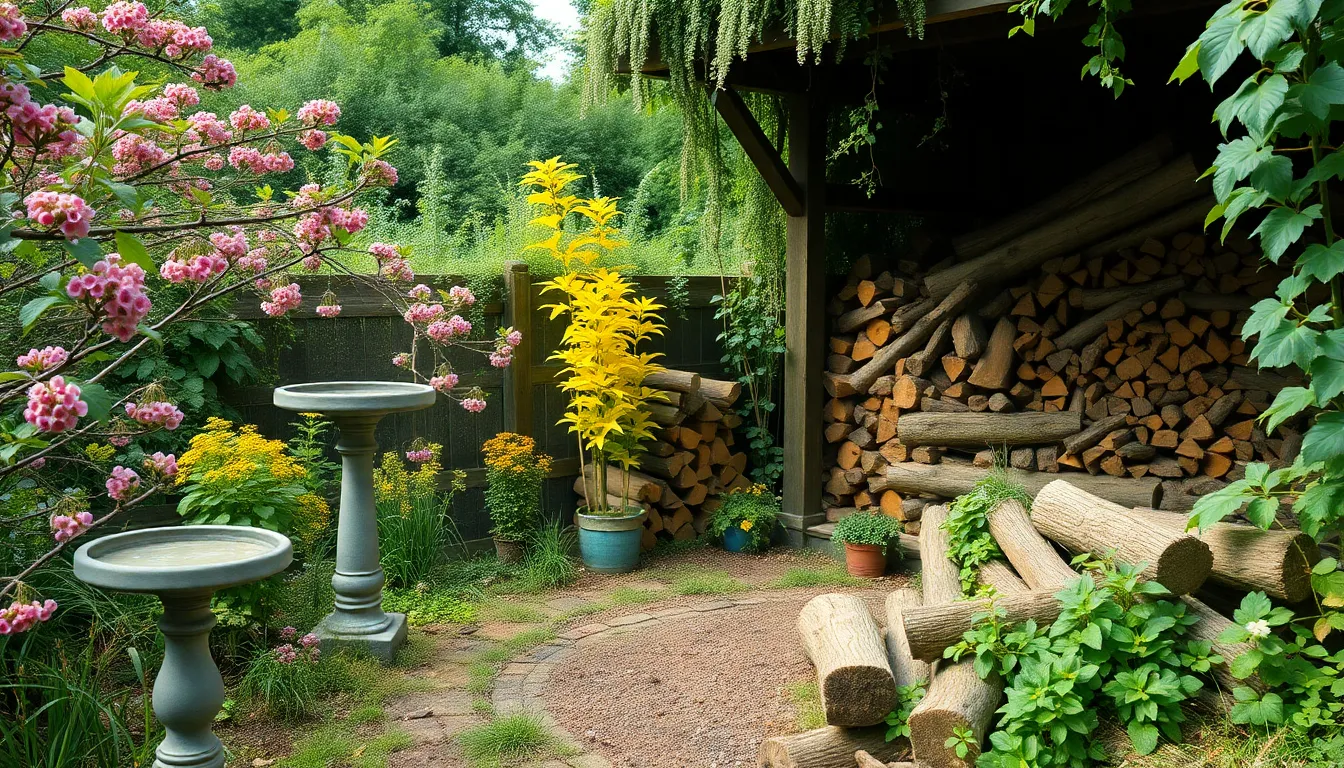
Transforming your UK garden into a wildlife sanctuary creates lasting benefits for local ecosystems while adding natural beauty to your outdoor space. Building this haven requires strategic plant selection and thoughtful habitat creation.
Plant Native UK Flowering Species
Native flowering plants form the foundation of wildlife attraction in UK gardens. Buckthorn serves as an essential host plant for brimstone butterflies, creating specialized breeding grounds for these vibrant pollinators. Butterfly friendly plants like these should flower at different times throughout the year to maintain continuous nectar sources.
Blackthorn emerges as one of the earliest bloomers, providing crucial food sources when wildlife needs them most. Apple trees and plum trees extend the flowering season while offering dual benefits of fruit production and pollinator support. Holly shrubs contribute year round structure plus provide berries for birds during harsh winter months.
Silver birches create vertical interest while supporting over 300 insect species. These native trees offer nesting sites and food sources that exotic species simply cannot match. Native species adapt perfectly to local soil conditions and weather patterns, requiring minimal maintenance once established.
Install Bird Baths and Feeding Stations
Bird feeding stations transform gardens into bustling wildlife hubs throughout the year. Seed feeders attract finches, tits, and sparrows while suet feeders provide essential high energy nutrition during harsh weather conditions. Position multiple feeding stations at different heights to accommodate various bird species’ preferences.
Shallow bird baths offer essential water sources that many gardens lack. Install these baths at ground level for ground feeding birds and elevate others to attract different species. Fresh water serves dual purposes as drinking sources and bathing areas that help birds maintain their feathers.
Strategic placement maximizes wildlife activity while providing excellent viewing opportunities. Position feeding stations near natural cover like shrubs or trees, giving birds quick escape routes from predators. Change water regularly to prevent algae buildup and disease transmission among visiting wildlife.
Create Natural Shelter Areas
Woodpiles in shady garden corners create instant insect hotels and small animal habitats. Stack dead wood loosely to form gaps and crevices where beetles, spiders, and beneficial insects can overwinter safely. These decomposing materials also enrich surrounding soil as they break down naturally.
Compost piles serve double duty as waste recyclers and wildlife attractors. Maintain active compost areas that generate warmth and attract insects, which in turn draw insectivorous birds and small mammals. Kitchen scraps and garden waste transform into valuable soil amendments while supporting garden ecosystems.
Dense native shrub plantings provide year round shelter for various wildlife species. Holly bushes offer evergreen protection plus food sources through their berry production. Layer different shrub heights to create varied habitat zones that accommodate everything from ground dwelling creatures to nesting birds.
Establish a Productive Kitchen Garden
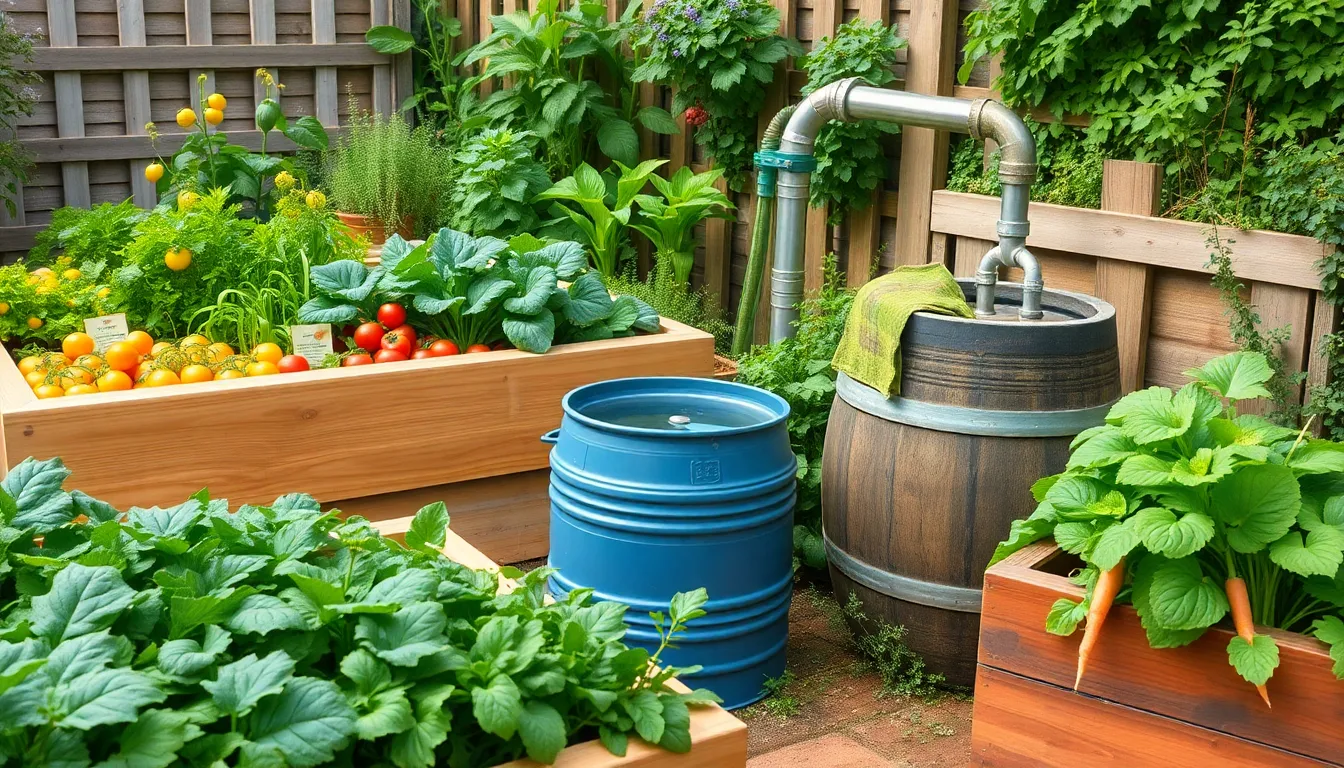
Creating a productive kitchen garden transforms our outdoor space into a sustainable food source that provides fresh vegetables year-round. We’ll explore three essential strategies that maximize yield while maintaining soil health and conserving resources.
Plan Seasonal Vegetable Rotations
Seasonal vegetable rotations form the foundation of our productive kitchen garden by preventing soil depletion and disease buildup. We organize our growing space into four distinct sections, dedicating each area to different crop families throughout the year.
Spring plantings include early potatoes, peas, and fresh salad greens that thrive in cooler temperatures. Summer crops feature heat-loving plants like tomatoes, courgettes, and leafy greens that flourish during warmer months. Autumn harvests bring us carrots, beetroot, and spinach that can withstand decreasing temperatures. Winter vegetables such as broccoli and kale provide fresh produce during the coldest months.
Root vegetables occupy one section while legumes enrich another area with nitrogen-fixing capabilities. Salad crops combined with herbs create a third productive zone, and leafy greens mixed with fruiting plants complete our rotation system. Annual crop rotation ensures that no plant family occupies the same bed consecutively, maintaining optimal soil fertility and reducing pest pressure naturally.
Build Raised Growing Beds
Raised growing beds offer superior drainage, warmer soil temperatures, and reduced physical strain compared to traditional ground-level gardening. We construct these elevated planting areas using durable materials like treated wood or recycled plastic that withstand UK weather conditions.
Construction specifications require beds measuring at least 6-8 inches deep to accommodate proper root development. Width should not exceed 4 feet to allow easy access from both sides without stepping on the soil. Length can vary based on available space, but 8-12 feet provides optimal growing area while maintaining manageable proportions.
Material selection focuses on longevity and safety, avoiding materials that might leach harmful chemicals into our food crops. Cedar and oak naturally resist decay, while composite materials offer consistent performance across seasons. We fill these frames with quality compost mixed with topsoil to create the ideal growing medium.
Raised beds naturally deter common garden pests like slugs and snails while improving accessibility for gardeners with mobility challenges. Better drainage prevents waterlogged roots during heavy rainfall periods common throughout the UK growing season.
Install Water Collection Systems
Water collection systems reduce our reliance on municipal supplies while providing plants with chemical-free rainwater they naturally prefer. We install rain barrels or larger storage tanks positioned strategically around our garden to capture runoff from roofs, sheds, and other structures.
Rainwater harvesting equipment includes guttering modifications, downspout diverters, and storage containers sized according to our garden’s water needs. A 50-gallon barrel serves small kitchen gardens, while larger plots benefit from 200-500 gallon tanks that sustain crops through dry spells.
System components feature mesh screens preventing debris accumulation, spigots for easy water access, and overflow mechanisms directing excess water away from structures. We position collection points near raised beds to minimize hose length and water pressure loss during irrigation.
Collected rainwater proves especially valuable during summer drought periods when water restrictions might limit garden irrigation. This sustainable approach reduces utility costs while providing plants with naturally soft water free from chlorine and other municipal treatment chemicals.
Develop a Low-Maintenance Drought-Resistant Garden
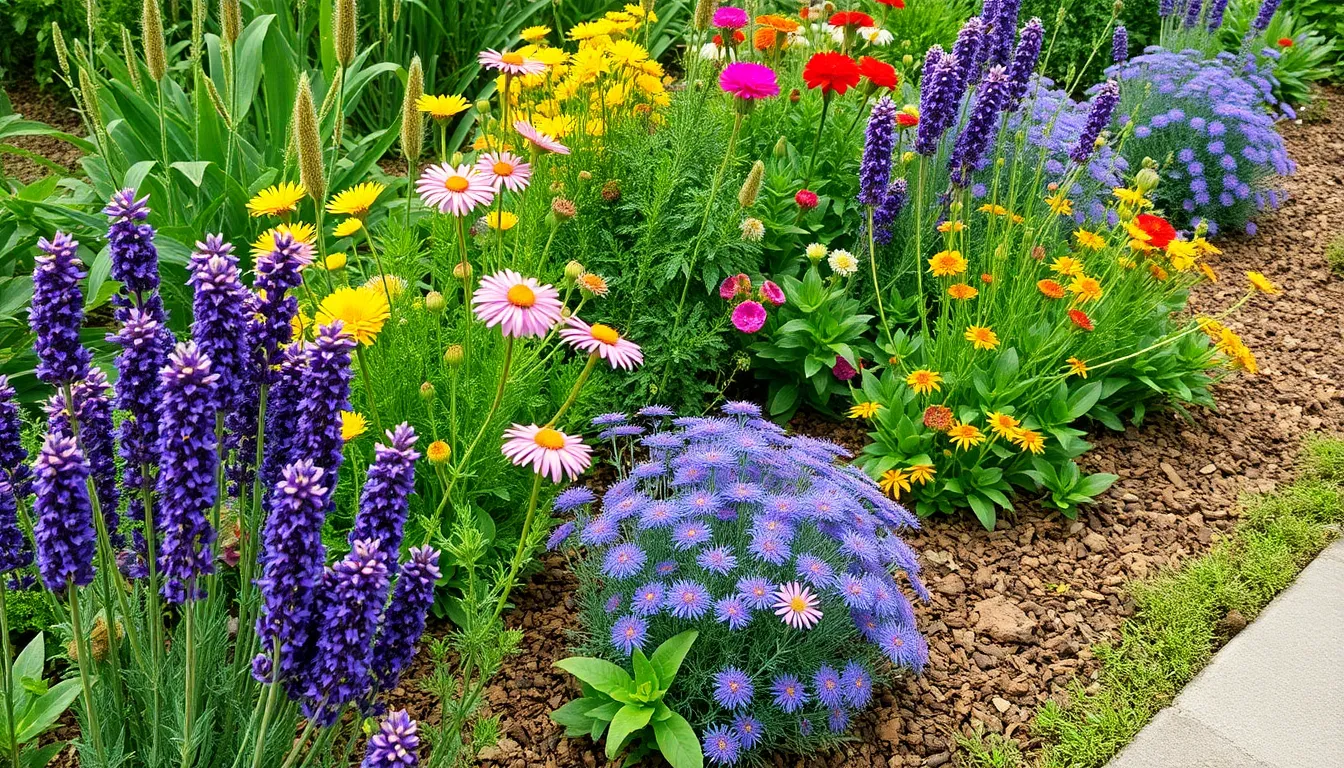
Creating resilient outdoor spaces that thrive with minimal water becomes increasingly important as UK weather patterns shift. We can achieve stunning results by combining strategic plant selection with smart gardening techniques.
Select Hardy Perennial Plants
Lavender varieties offer the perfect foundation for drought resistant gardens, with Lavandula angustifolia producing fragrant purple blooms while thriving in well-drained soil conditions. Sempervivum and Echeveria succulents provide excellent water retention capabilities and come in diverse shapes and vibrant colors that add visual interest throughout dry spells.
Yarrow plants (Achillea millefolium) adapt exceptionally well to challenging dry conditions while requiring minimal maintenance attention from gardeners. These hardy perennials establish deep root systems that access moisture from lower soil levels, making them ideal candidates for sustainable garden designs.
Mediterranean herbs like rosemary and oregano complement drought resistant plantings while serving dual purposes in kitchen gardens. Native grasses such as festuca and miscanthus create natural texture and movement while demanding very little supplemental watering once established.
Use Mulching and Ground Cover Techniques
Soil preparation forms the foundation of successful drought resistant gardening by deeply cultivating earth and incorporating large quantities of organic matter to improve moisture retention capabilities. Compost and aged manure create soil structures that hold water more effectively during extended dry periods.
Organic mulching materials like shredded bark and leaf mold help retain soil moisture while reducing evaporation rates and suppressing competitive weeds. We recommend applying 3-4 inch layers around plants, keeping mulch away from plant stems to prevent moisture related diseases.
Living ground covers such as creeping thyme and sedum varieties create dense carpets that conserve soil moisture while eliminating the need for traditional lawn maintenance. These spreading plants form natural weed barriers while requiring minimal water inputs once established in garden beds.
Install Efficient Irrigation Methods
Drip irrigation systems deliver water directly to plant root zones, reducing waste and runoff while ensuring targeted moisture delivery where plants need it most. These efficient systems can reduce water consumption by up to 50% compared to traditional sprinkler methods.
Rainwater harvesting techniques significantly reduce municipal water dependence during dry periods by collecting and storing natural precipitation in barrels or cisterns. We can connect these systems to drip irrigation networks for automated watering during drought conditions.
Timer controlled watering schedules optimize moisture delivery by providing consistent hydration during early morning hours when evaporation rates remain lowest. Smart irrigation controllers adjust watering frequency based on weather conditions and soil moisture sensors, preventing overwatering while maintaining plant health.
Transform Small Spaces Into Garden Retreats
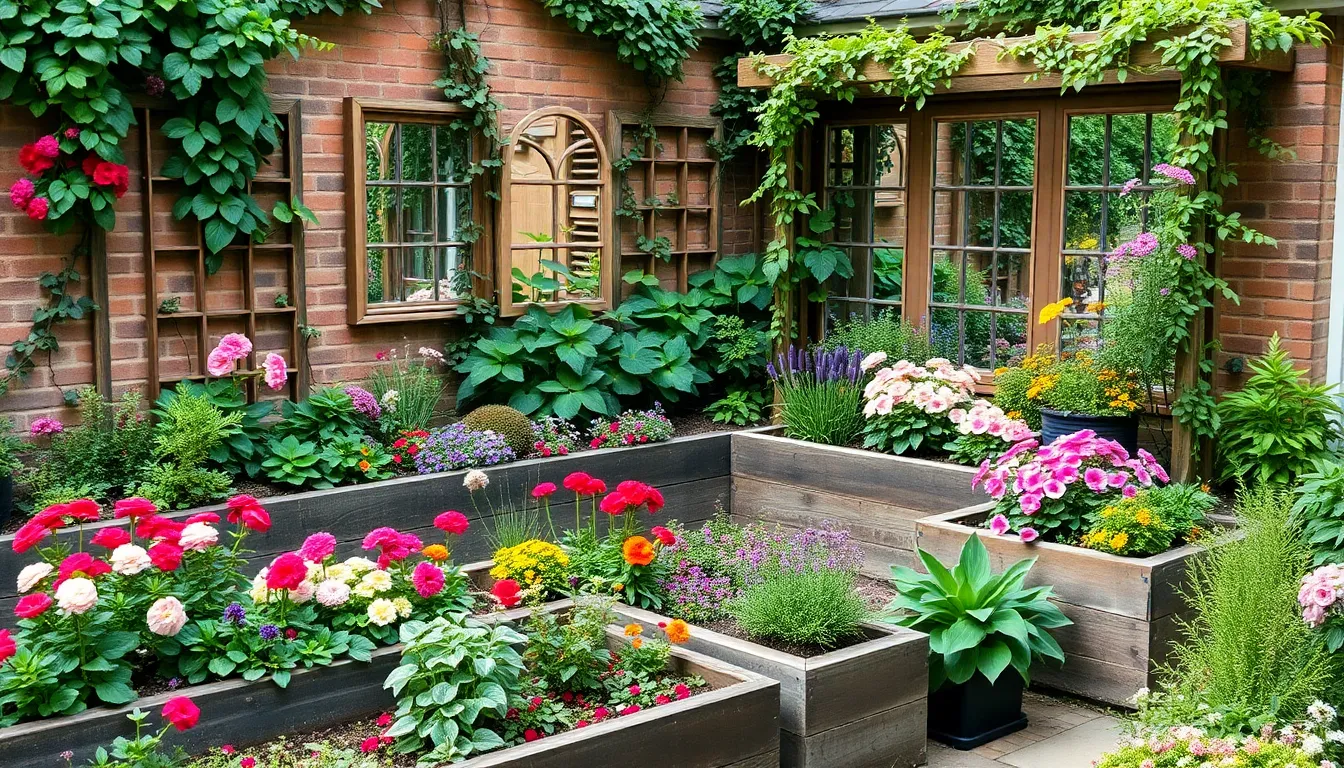
We’ll explore proven techniques to maximize every square foot of your UK garden space. These strategies help create stunning outdoor retreats regardless of your garden’s size constraints.
Maximize Vertical Growing Opportunities
Hanging planters and arches transform unused vertical space into productive growing areas while freeing up valuable floor space. We recommend installing wall-mounted planters at varying heights to create visual interest and accommodate different plant sizes.
Climbing plants like roses and wisteria add dramatic vertical elements that draw the eye upward. Evergreen climbers such as ornamental ivy and clematis provide year-round visual appeal while maximizing your growing potential.
Wall-mounted systems allow you to layer plants vertically without overwhelming your ground space. These installations work particularly well for herbs, trailing flowers, and compact vegetables that thrive in contained environments.
Create Multi-Level Planting Areas
Level changes using small trees combined with perennials, grasses, and shrubs add depth without requiring major earthworks. This approach creates natural terracing that makes small spaces appear larger and more intricate.
Tiered planting beds establish distinct growing zones at different heights throughout your garden. We suggest using raised planters of varying heights to create these levels while improving drainage and accessibility.
Living boundaries replace traditional fencing with natural plant barriers that blend seamlessly with your garden design. These green borders using native shrubs and flowering plants create privacy while maintaining an open, spacious feeling.
Use Mirrors to Enhance Space Perception
Strategic mirror placement creates the illusion of expanded garden space by reflecting natural light and existing plantings. Position mirrors to capture your best garden views and double their visual impact.
Reflected light from carefully angled mirrors brightens shadowy corners and makes enclosed spaces feel more open. This technique works especially well in urban courtyards and narrow side gardens where natural light is limited.
Visual depth increases dramatically when mirrors reflect pathways or garden vistas back into your space. We recommend using weather-resistant outdoor mirrors positioned to avoid creating harsh glare while maximizing the space-improving effect.
Design a Family-Friendly Garden Play Area
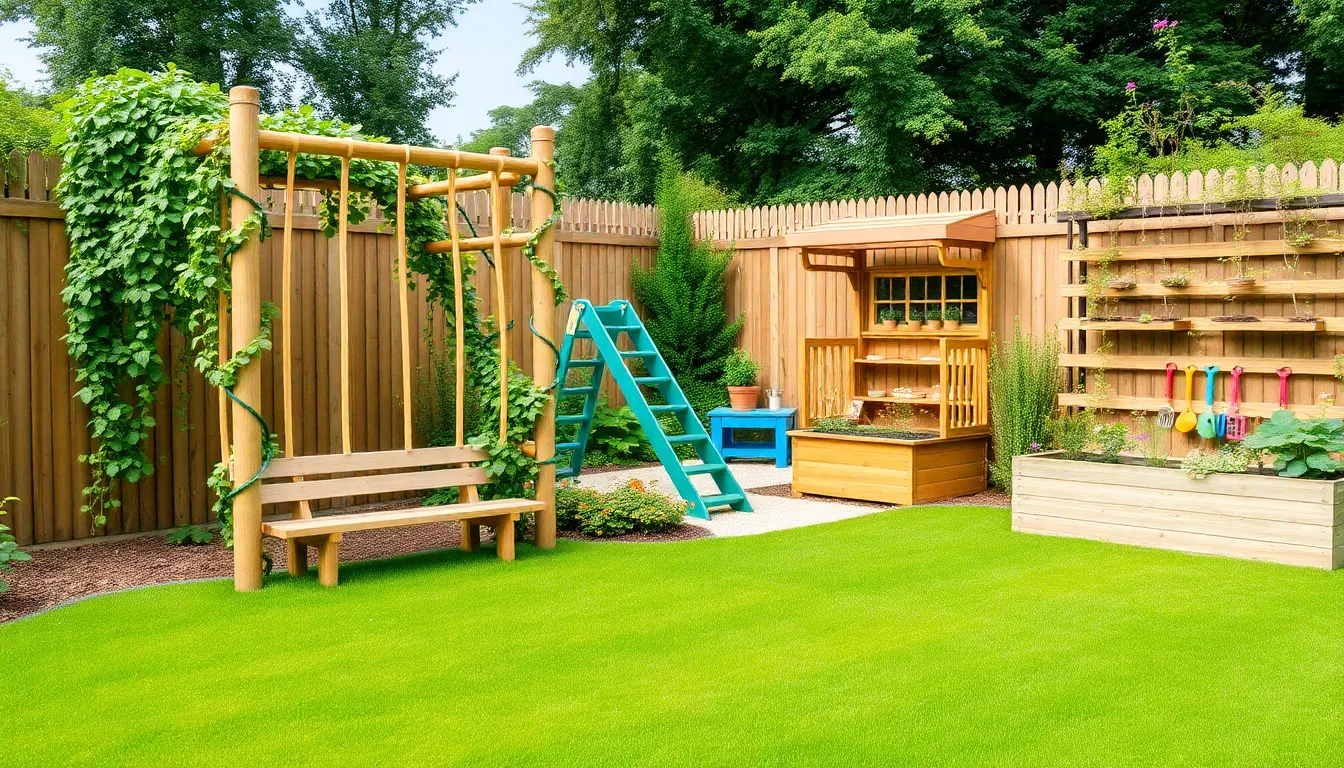
Creating spaces where children can safely play while learning connects families with nature and encourages outdoor exploration. We’ll show you how to blend functionality with fun in your UK garden design.
Install Safe Play Equipment
Multi-functional climbing frames serve dual purposes by combining play structures with garden pergolas to maintain visual cohesion. These versatile installations support climbing plants like jasmine or clematis while providing children with captivating physical challenges.
Secure anchoring systems ensure all equipment meets UK safety standards and prevents accidents during active play. We recommend using concrete footings for larger structures and checking installation guidelines from manufacturers like Wickes or B&Q.
Natural material benches double as climbing surfaces and jump platforms while blending seamlessly with garden aesthetics. Cedar and treated pine options withstand British weather conditions and provide comfortable seating for supervising adults.
Integrated sports features like basketball hoops attached to fence posts or table tennis surfaces built into patio areas encourage active family participation. Goal posts positioned on lawn edges create defined play zones without overwhelming garden design.
Create Dedicated Growing Zones for Children
Raised growing beds positioned at child height make gardening accessible and exciting for young participants. Standard heights of 18-24 inches work well for children aged 5-12 and reduce strain on adult backs during supervision.
Fast growing vegetables like radishes and lettuce provide quick satisfaction and maintain children’s interest throughout growing seasons. Cherry tomatoes and sunflowers create impressive visual impact while teaching patience through longer growing cycles.
Child sized gardening tools stored in weatherproof containers near growing areas encourage independence and proper care habits. Colorful watering cans and small spades sized for little hands make gardening tasks manageable and enjoyable.
Educational plant markers help children track progress and learn plant identification skills. Wooden stakes with chalkboard surfaces allow kids to write plant names and planting dates while personalizing their garden spaces.
Plan Open Lawn Areas for Activities
Designated activity zones create clear boundaries for different types of play without restricting movement between areas. We suggest allocating 40-50% of available lawn space for active play while reserving quieter corners for reading or nature observation.
Durable grass varieties like perennial ryegrass withstand heavy foot traffic and recover quickly from wear patterns. These hardy options maintain green appearance throughout British growing seasons and require minimal overseeding.
Flexible seating arrangements using moveable garden furniture allow spaces to adapt for picnics, games, or relaxation as family needs change. Folding picnic tables and stackable chairs provide functionality without permanent space commitment.
Boundary plantings of low shrubs like lavender or ornamental grasses define play areas while maintaining open sightlines for supervision. These natural borders add fragrance and seasonal interest while keeping balls and toys contained within designated zones.
Establish a Seasonal Four-Season Garden
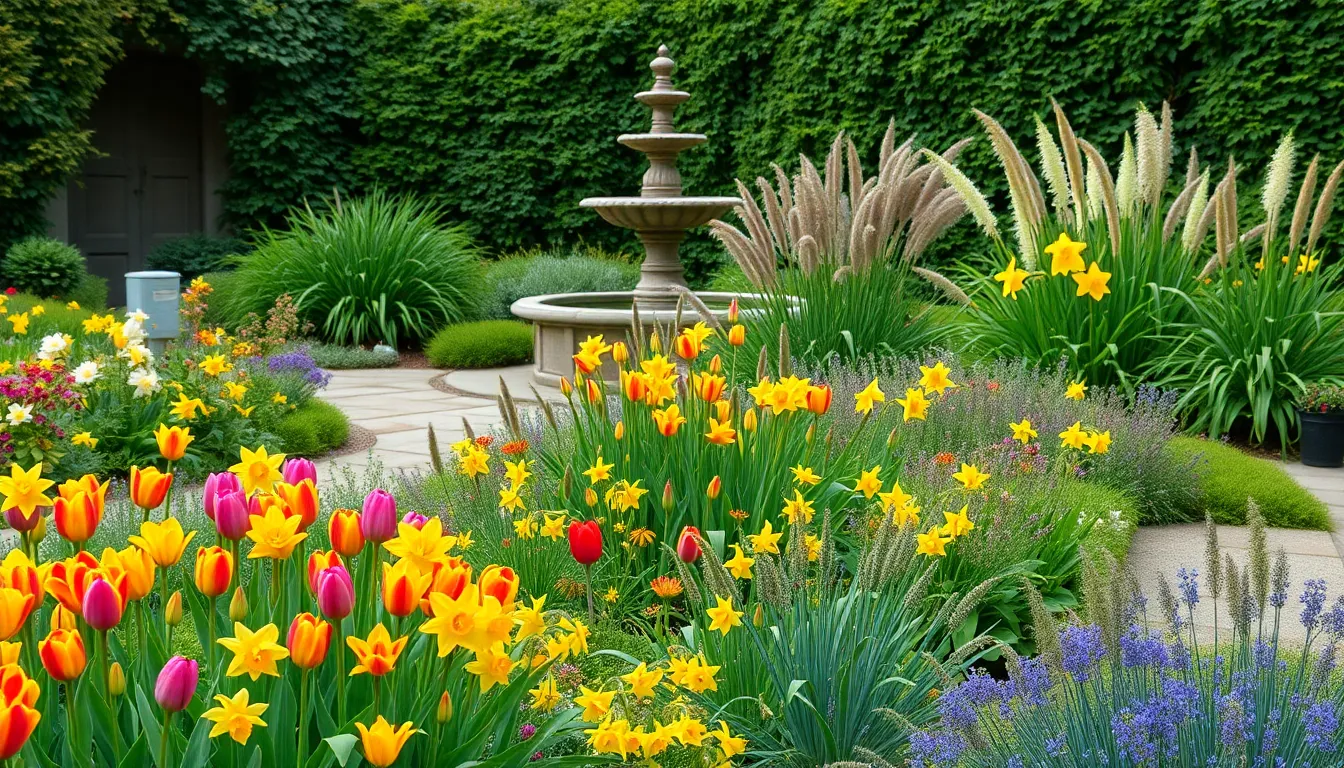
Building upon your garden foundation, we’ll create year-round visual appeal through strategic plant selection and structural elements. This approach ensures your UK garden maintains interest and beauty regardless of the season.
Plant Spring Bulbs and Early Bloomers
Spring bulbs deliver the first burst of color after winter’s dormancy period. We recommend planting tulips, daffodils, crocuses, and hyacinths in grouped clusters for maximum visual impact rather than scattered individual placements.
Early-blooming perennials and shrubs extend your spring display beyond bulb flowering periods. Hellebores provide elegant white and purple blooms while quince offers vibrant coral flowers on bare branches. These companions create layered interest that bridges the gap between late winter and early summer.
Mass plantings of single bulb varieties create more dramatic effects than mixed combinations. We suggest dedicating exact garden areas to coordinated spring displays, allowing each variety to shine during its peak blooming window.
Design Summer Color Combinations
Summer borders require careful planning to achieve sustained color throughout the season’s peak growing months. Perennial combinations featuring lavender, roses, echinacea, and hydrangeas provide reliable flowering displays with varying bloom times and heights.
Ornamental grasses add textural contrast and movement to summer plantings. We incorporate varieties like fountain grass and feather reed grass to create backdrop elements that complement flowering perennials without competing for attention.
Color schemes using complementary or contrasting combinations create more impactful displays than random mixed plantings. Structural plants frame these colorful arrangements while providing visual anchors that prevent the design from appearing chaotic or unplanned.
Include Winter Interest Plants and Structures
Winter gardens depend heavily on evergreen shrubs and trees with distinctive bark characteristics for visual appeal. Birch trees offer striking white bark while holly and pyracantha provide colorful berry displays that persist through cold months.
Structural elements become prominent features when deciduous plants lose their foliage. Rock features, paving patterns, and garden sculptures create focal points that maintain design integrity during dormant seasons.
Water fountains, bird feeders, and decorative lanterns add life and movement to winter gardens. These functional elements serve dual purposes by supporting wildlife while providing visual interest during months when flowering plants aren’t active.
Conclusion
Creating the perfect UK garden doesn’t have to be overwhelming when you understand your space and climate. We’ve covered everything from traditional cottage gardens to modern balcony designs that work beautifully in Britain’s unique conditions.
Whether you’re planning a wildlife sanctuary or a productive kitchen garden the key is choosing plants that thrive naturally in our climate. Native species combined with smart design principles will give you a garden that looks stunning year-round while requiring minimal maintenance.
Remember that even the smallest spaces can become beautiful green retreats with vertical growing and clever design tricks. Start with one section that excites you most and gradually expand your garden vision from there.
Your perfect UK garden is waiting to be created – it’s time to get started!
Frequently Asked Questions
What makes UK gardens unique compared to other countries?
UK gardens benefit from a moderate climate and ample rainfall, making them ideal for cultivating diverse plants year-round. The unpredictable weather and often limited space present unique challenges, but also opportunities to create stunning gardens ranging from traditional cottage styles to modern urban balcony spaces that thrive in the British climate.
What plants are best for creating an authentic English cottage garden?
Heritage varieties like hollyhocks, delphiniums, and foxgloves form the backbone of cottage gardens. Traditional herbs such as lavender and rosemary add fragrance, while self-seeding flowers like sweet peas and poppies provide effortless charm. Native wildflowers enhance authenticity while requiring minimal maintenance, perfectly complementing the informal cottage garden aesthetic.
How can I maximize space in a small urban balcony garden?
Install vertical growing systems like hanging baskets and wall-mounted pockets to utilize vertical space. Choose compact container plants such as herbs, cherry tomatoes, and leafy greens. Use climbing plants like clematis on railings, and select folding furniture or built-in storage benches to optimize floor space while maintaining functionality.
Which plants attract wildlife to UK gardens?
Native flowering species like buckthorn and blackthorn attract pollinators and provide food sources. Plant dense native shrubs for year-round shelter. Install bird baths and feeding stations for avian visitors. Create natural habitats with woodpiles and compost areas, which also enrich soil while providing homes for beneficial insects and small wildlife.
What vegetables grow best in UK kitchen gardens?
Plan seasonal rotations with spring crops like lettuce and radishes, summer tomatoes and beans, autumn root vegetables, and winter brassicas. Use raised beds for better drainage and pest control. Hardy herbs like rosemary and thyme provide year-round harvests, while quick-growing salads ensure continuous fresh produce throughout growing seasons.
How do I create a drought-resistant garden in the UK?
Select hardy perennials like lavender, yarrow, and Mediterranean herbs that thrive in dry conditions. Prepare soil with organic mulching and ground cover plants to retain moisture. Install efficient irrigation systems like drip irrigation and rainwater harvesting to optimize water usage during increasingly common dry spells in changing UK weather patterns.
What’s the best way to make a small garden appear larger?
Maximize vertical space with hanging planters and wall-mounted systems. Create multi-level planting with tiered beds and living boundaries for depth. Use mirrors strategically to reflect light and garden views, creating illusions of expanded space. Install climbing structures and choose plants that grow upward rather than outward to optimize limited ground space.
How can I design a safe garden play area for children?
Install multi-functional climbing frames that double as garden pergolas with secure anchoring systems. Create dedicated growing zones with raised beds at child height and fast-growing vegetables to engage young gardeners. Plan open lawn areas with durable grass varieties and flexible seating, while using boundary plantings to define spaces safely.
What plants provide year-round garden interest?
Plant spring bulbs like tulips and daffodils in clusters, paired with early bloomers like hellebores. Summer perennials and ornamental grasses maintain color through warm months. Winter interest comes from evergreen shrubs, distinctive bark trees, and structural elements like rock features. This layered approach ensures visual appeal throughout all four seasons.
What drainage considerations are important for UK container gardens?
Proper drainage is crucial in the UK’s wet climate. Use containers with adequate drainage holes and add gravel or broken pottery at the bottom. Select well-draining potting mix and avoid saucers that collect water. Elevate containers slightly to prevent waterlogging, especially during heavy rainfall periods common in British weather patterns.

